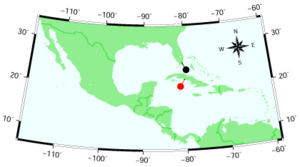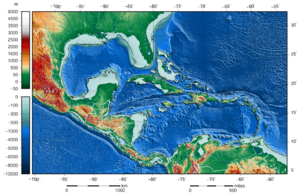Pristine mustached bat facts for kids
Quick facts for kids Pristine mustached bat |
|
|---|---|
| Conservation status | |
| Scientific classification | |
| Genus: |
Pteronotus
|
| Species: |
pristinus
|
The pristine mustached bat (Pteronotus pristinus) was a type of bat that is now extinct. It lived during the late Quaternary period, which is a very long time ago! This bat belonged to a family called Mormoopidae, which are found in warm, tropical parts of the Americas.
Scientists believe this bat lived in Cuba and possibly also in Florida, United States.
Where Did This Bat Live?
This special bat is only known from its subfossils. Subfossils are old bones or other remains that haven't quite turned into rock like true fossils.
Scientists first found its remains in old caves in Cuba. These caves were in a place called Trinidad, in the Las Villas Province. Later, more possible remains were found in caves in southern Florida. One of these places was called Monkey Jungle Hammock.
The bones found in Florida were two mandibles, which are lower jawbones. Scientists think they might be from the pristine mustached bat. However, they couldn't compare them directly with the bones found in Cuba. The Cuban finds included several skulls and other body parts.
It's interesting because this is the only time the Pteronotus group of bats has ever been found in the United States, either as fossils or living today. Cuba was likely the place where these bats came from to reach Florida.
Why Did This Bat Disappear?
In Florida, the pristine mustached bat disappeared at the end of the Pleistocene Ice Age. This probably happened because the sea level started to rise a lot. When the sea rose, it flooded the caves where these bats lived. Bats need dry, safe caves to roost (rest) and raise their young. Losing these homes was a big problem.
During the late Pleistocene, the sea level in Florida was much lower, sometimes as much as 100 meters (about 330 feet) lower than it is today. The water inside the caves was also lower. This meant that cave systems in places like Monkey Jungle Hammock and Cutler Hammock were dry and had a warm, humid climate that bats liked.
But as the Ice Age ended, the sea level went up. This caused the caves to flood. The special warm and humid conditions inside these "hot caves" were destroyed. Today, two of these caves are now sinkholes filled with sediment, just a few meters above sea level. The third cave is completely underwater.
This rise in sea level also caused other cave-dwelling bats to disappear from these areas. This included another tropical bat called the ghost-faced bat and a North American bat called the southeastern myotis. Even the big brown bat became rare in Florida caves.
Scientists have seen similar patterns of bats disappearing on many small islands in the West Indies, like the Bahamas and Cayman Islands. This shows how much changes in sea level can affect animals that rely on specific habitats like caves.




